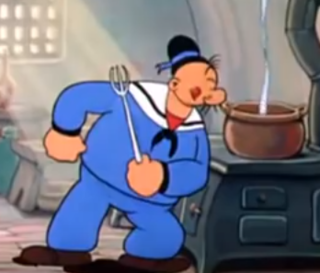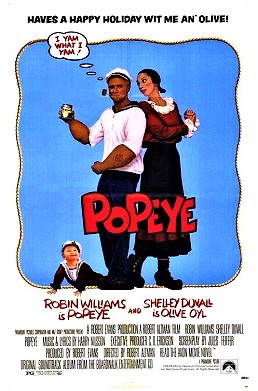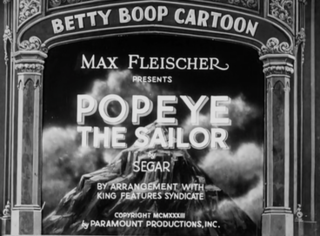
Olive Oyl is a cartoon character created by E. C. Segar in 1919 for his comic strip Thimble Theatre. The strip was later renamed Popeye after the sailor character that became the most popular member of the cast; however, Olive Oyl was a main character for a decade before Popeye's 1929 appearance.

J. Wellington Wimpy, generally referred to as Wimpy, is one of the characters in the comic strip Popeye, created by E. C. Segar and originally called Thimble Theatre, and in the Popeye cartoons based upon the strip. Wimpy debuted in the strip in 1931 and was one of the dominant characters in the newspaper strip, but when Popeye was adapted as an animated cartoon series by Fleischer Studios, Wimpy became a minor character; Dave Fleischer said that the character in the original Segar strip was "too smart" to be used in the film cartoon adaptations. Wimpy appears in Robert Altman's 1980 live-action musical film Popeye, played by Paul Dooley.

Winfield B. Mercer, professionally known as Jack Mercer, was a prolific American voice actor, animator and TV screenwriter. He is best known as the voice of cartoon characters Popeye the Sailor Man and Felix the Cat. The son of vaudeville and Broadway performers, he also performed on the vaudeville and legitimate stages.

Popeye is a 1980 American musical comedy film directed by Robert Altman and produced by Paramount Pictures and Walt Disney Productions. It is based on E. C. Segar's Popeye comics character. The script was written by Jules Feiffer, and stars Robin Williams as Popeye the Sailor Man and Shelley Duvall as Olive Oyl. Its story follows Popeye's adventures as he arrives in the town of Sweethaven.

Popeye the Sailor Meets Sindbad the Sailor is a 1936 two-reel animated cartoon short subject in the Popeye Color Specials series, produced in Technicolor and released to theatres on November 27, 1936, by Paramount Pictures. It was produced by Max Fleischer for Fleischer Studios, Inc. and directed by Dave Fleischer, with the title song's music composed by Sammy Timberg and lyrics written by Bob Rothberg. The voice cast includes Jack Mercer as Popeye, Gus Wickie as Sindbad the Sailor, Mae Questel as Olive Oyl and Lou Fleischer as J. Wellington Wimpy.

Popeye the Sailor Meets Ali Baba's Forty Thieves is a two-reel animated cartoon short subject in the Popeye Color Specials series, produced in Technicolor and released to theatres on November 26, 1937 by Paramount Pictures. It was produced by Max Fleischer for Fleischer Studios, Inc. and directed by Dave Fleischer. Willard Bowsky was head animator, with musical supervision by Sammy Timberg. The voice of Popeye is performed by Jack Mercer, with additional voices by Mae Questel as Olive Oyl, Lou Fleischer as J. Wellington Wimpy and Gus Wickie as Abu Hassan.
Swee'Pea is a character in E. C. Segar's comic strip Thimble Theatre/Popeye and in the cartoon series derived from it. His name refers to the flower known as the sweet pea. Before his addition to the animated shorts, the name "Sweet Pea" was a term of affection used by main character Popeye. In the cartoon We Aim to Please, he addressed girlfriend Olive Oyl that way.

Popeye the Sailor is a 1933 animated short produced by Fleischer Studios and distributed by Paramount Publix Corporation. While billed as a Betty Boop cartoon, it was produced as a vehicle for Popeye in his debut animated appearance.
Olive Oyl for President is a 1948 entry in the Popeye the Sailor animated short subject series, produced by Famous Studios and released on January 30, 1948 by Paramount Pictures. The short is a reworking of a 1932 Betty Boop cartoon, Betty Boop for President, and depicts what Popeye imagines the world would be like if Olive Oyl were president.

Popeye the Sailor is an American animated television series produced for King Features Syndicate TV starring Popeye that was released between 1960 and 1963 with 220 episodes produced. The episodes were produced by a variety of production studios and aired in broadcast syndication until the 1990s.

The All New Popeye Hour is an American animated television series produced by King Features Entertainment In association with Hanna Barbera Productions. Starring the comic strip character Popeye, the series aired from 1978 to 1983 Saturday mornings on CBS. Despite the series' mixed reception, it was a hit for King Features Entertainment.

Popeye the Sailor is an American animated series of short films based on the Popeye comic strip character created by E. C. Segar. In 1933, Max and Dave Fleischer's Fleischer Studios, based in New York City, adapted Segar's characters into a series of theatrical cartoon shorts for Paramount Pictures. The plotlines in the animated cartoons tended to be simpler than those presented in the comic strips, and the characters slightly different. A villain, usually Bluto, makes a move on Popeye's "sweetie", Olive Oyl. The villain clobbers Popeye until he eats spinach, giving him superhuman strength. Thus empowered, Popeye makes short work of the villain.
Spooky Swabs is a Popeye theatrical cartoon short, starring Jack Mercer as Popeye, Mae Questel as Olive Oyl and Mercer, Jackson Beck, Sid Raymond and Gilbert Mack as the ghosts. Produced by Paramount Cartoon Studios and directed by Isadore Sparber, it was released in 1957 and is the final cartoon in the Popeye series of theatrical cartoons released by Paramount Pictures.

The Sea Hag is a fictional character owned by King Features Syndicate. She is a tall, masculine-looking witch featured in comics/cartoons as a nemesis to the character Popeye. The Sea Hag was created by Elzie Crisler Segar in 1929 as part of the Thimble Theatre comic strip.

You're a Sap, Mr. Jap is a 1942 one-reel anti-Japanese Popeye the Sailor animated cartoon short subject released by Paramount Pictures on August 7, 1942. It was the first cartoon short to be produced by Famous Studios. It is one of the best-known World War II propaganda cartoons.

Popeye the Sailor is a fictional cartoon character created by Elzie Crisler Segar. The character first appeared on January 17, 1929, in the daily King Features comic strip Thimble Theatre. The strip was in its tenth year when Popeye made his debut, but the one-eyed sailor quickly became the lead character, and Thimble Theatre became one of King Features' most popular properties during the 1930s. Following Segar's death in 1938, Thimble Theatre was continued by several writers and artists, most notably Segar's assistant Bud Sagendorf. It was formally renamed Popeye. The strip continues to appear in first-run installments on Sundays, written and drawn by R.K. Milholland. The daily strips are reprints of old Sagendorf stories.
Bonnie Poe was an American actress and voice artist, best known for providing the voice for the Fleischer Studios animated character Betty Boop beginning in 1933, starting with the Popeye the Sailor series and featuring in a dozen cartoons. She voiced her in a live-action segment on the special Hollywood on Parade No. A-8, performing a skit with Bela Lugosi providing a portrayal of Count Dracula.

Seasin's Greetinks! is a Popeye theatrical Christmas-themed cartoon short, starring William "Billy" Costello as Popeye and Bonnie Poe as Olive Oyl and William Pennell as Bluto. It was released on December 17, 1933 and was a cartoon in the Popeye the Sailor series of theatrical cartoons released by Paramount Pictures.

Wild Elephinks is a Popeye theatrical cartoon short, starring William "Billy" Costello as Popeye, Bonnie Poe as Olive Oyl, William Pennell as a Lion and Charles Lawrence as Wimpy. It was released in 1933 and was the fifth entry in the Popeye the Sailor series of theatrical cartoons released by Paramount Pictures, lasting through 1957.

Let's You and Him Fight is a Popeye theatrical cartoon short released in February 16, 1934, starring William "Billy" Costello as Popeye, Bonnie Poe as Olive Oyl, William Pennell as Bluto and Charles Lawrence as the announcer.
















